Cité de la Musique
The Cité de la Musique ("City of Music"), also known as Philharmonie 2, is a group of institutions dedicated to music and situated in the Parc de la Villette, 19th arrondissement of Paris, France. It was designed with the nearby Conservatoire de Paris (CNSMDP) by the architect Christian de Portzamparc and opened in 1995. Part of François Mitterrand's Grands Projets, the Cité de la Musique reinvented La Villette – the former slaughterhouse district.[1]
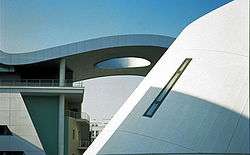
It consists of an amphitheater, a concert hall that can accommodate an audience of 800–1,000, a music museum containing an important collection of classical music instruments dating mainly from the fifteenth- to twentieth-century, a music library, exhibition halls and workshops. In 2015 it was renamed Philharmonie 2 as part of the Philharmonie de Paris when a larger symphony hall was built by Jean Nouvel and named Philharmonie 1. Its official address is 221, Avenue Jean Jaurès, 75019 Paris.[2]
Philharmonie 1
Philharmonie 1 (part of the Philharmonie de Paris), a new 2400-seat symphony hall, is a project whose construction had been postponed for about twenty years, to complete the Cité de la Musique.
On 6 March 2006 the French minister of Culture and communication Renaud Donnedieu de Vabres, the mayor of Paris Bertrand Delanoë, and the director of the Cité de la Musique, Laurent Bayle, announced the beginning of the construction at a press conference concerning the reopening of the Salle Pleyel, now associated with the Museum.[3]
The cost of construction was expected to be 170 million euros, and will be shared by the national government (45 per cent), the Ville de Paris (45 per cent), and the Région Île-de-France (10 per cent). But the cost in the end is expected to be €381 million ($488 million) [4]
In April 2007 Jean Nouvel won the design competition for the auditorium. He brought in Brigitte Métra as his partner, along with Marshall Day Acoustics (room acoustics design) and Nagata Acoustics (peer-review and scale model study).[5][6]
The hall opened on 14 January 2015 with a performance by the Orchestre de Paris of Faure's Requiem to honour the victims of the Charlie Hebdo shootings, which had taken place in the city a week earlier. The opening concert was attended by François Hollande, the President of France.[7]
The first season of the Philharmonie de Paris started in January 2015. The purpose of the season was to reach out to new audiences by providing musical creation and varied repertory in classical music, dance, jazz, world music and contemporary music. On weekends, a diverse program of affordably-priced events and activities was offered each with a theme (such as the Love Stories weekend in February, David Bowie in early March or Paco de Lucia tribute weekend in May).[8]
Musée de la Musique
The Musée de la Musique features a collection of about 8,390 items, comprising around 4,442 musical instruments, 1,097 instrument elements or 939 pieces of art (paintings, sculptures, etc.) collected by the Conservatoire de Paris since 1793 as well as some archives and a library of 110,000 written and audiovisual documents. The museum's collection, which opened to the public in 1864 and was relocated at the Cité de la musique in 1997, contains instruments used in classical and popular music from the sixteenth century to the present time including lutes, archlutes, almost 200 classical guitars,[9] violins by Italian luthiers Antonio Stradivari,[10] the Guarneri family, Nicolò Amati; French and Flemish harpsichords; pianos by French piano-makers Erard and Ignaz Pleyel; saxophones by Adolph Sax, etc.
The instruments are exhibited in 5 departments by period and by type. Audio devices are provided at the entrance allowing visitors to hear commentary and excerpts of music played on the instruments, complemented by video screens and scale models along the visit.
Gallery
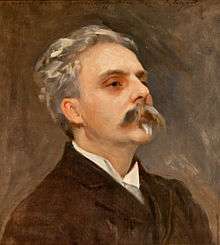 Gabriel Fauré by John Singer Sargent, c. 1889
Gabriel Fauré by John Singer Sargent, c. 1889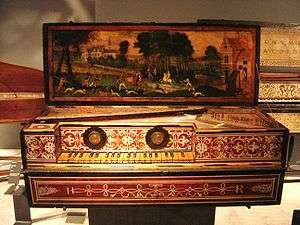
 17th century guitars
17th century guitars Harpsichords from the second half of the 18th century
Harpsichords from the second half of the 18th century 18th century instruments with a hunting horn by Carlin
18th century instruments with a hunting horn by Carlin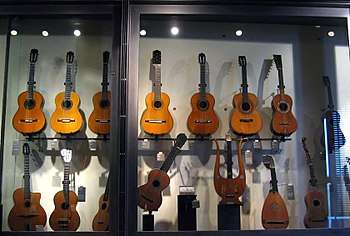 19th and 20th century guitars and by Antonio de Torres
19th and 20th century guitars and by Antonio de Torres Pianos from the beginning of the 19th century
Pianos from the beginning of the 19th century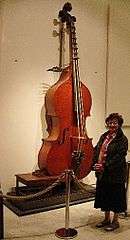 Octobasse by Jean-Baptiste Vuillaume, 19th century
Octobasse by Jean-Baptiste Vuillaume, 19th century
See also
- List of music museums
- Cité des Sciences et de l'Industrie, in Parc de la Villette
- La Géode, an IMAX domed theatre in Parc de la Villette
- Le Zénith, a concert arena in Parc de la Villette
References
- Fierro, Annette; p. 17 (2003). The Glass State: The Technology of the Spectacle, 1981–1998. MIT Press. ISBN 0-262-06233-X.
- "Plan and location of all the elements at the official website". Cité de la Musique. Retrieved 6 September 2007.
- "Renaud Donnedieu de Vabres et Bertrand Delanoë, maire de Paris, annoncent les partenariats noués entre l'Etat et la Ville de Paris pour le développement de la vie musicale symphonique à Paris" (Press release) (in French). Ministry of Culture and Communication. 6 March 2006. Retrieved 6 September 2007.
- France’s New Music Temple
- "Making acoustic choices for the future symphony hall". Philharmonie de Paris. Retrieved 5 March 2012.
- http://sourceable.net/acoustic-feats-worlds-costliest-concert-hall/# Archived 8 June 2015 at the Wayback Machine sourceable.com
- "In New Concert Hall, Paris Orchestra Honours Last Week's Terror Victims". 15 January 2015.
- Les guitares classiques du Musée de la musique (almost 200 classical guitars) Archived 13 March 2010 at the Wayback Machine; Instruments et oeuvres d'art Archived 25 July 2009 at the Wayback Machine – use search-phrase: Mot-clé(s) : guitare
- Instruments by Antonio Stradivarius at the Musée de la Musique, website of Philharmonie de Paris.
Further reading
- Kim Eling, The Politics of Cultural Policy in France, Chapter 3: "La Cité de la Musique", Macmillan, 1999, pages 38–61. ISBN 0-312-21974-1.
External links
| Wikimedia Commons has media related to Cité de la musique. |
- Cité de la Musique official website
- Médiathèque de la Cité de la musique (in French) – Listen to excerpts of concerts